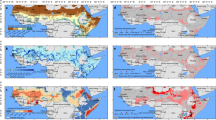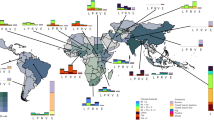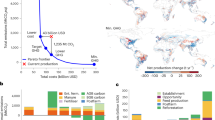Abstract
Tanzania’s dairy sector is poorly developed, creating reliance on imports for processed, value-added dairy products and threatening food security, particularly when supply chains are disrupted due to market volatility or armed conflicts. The Tanzanian Dairy Development Roadmap is a domestic development initiative that aims to achieve dairy self-sufficiency by 2030. Here, we model different outcomes of the roadmap, finding that adoption of high-yield cattle breeds is essential for reducing dairy import dependency. Avoided land use change resulting from fewer, higher yielding dairy cattle would lead to lower greenhouse gas emissions. Dairy producers’ average incomes could increase despite capital expenditure and land allocation required for the adoption of high-yield breeds. Our findings demonstrate the importance of bottom-up development policies for sustainable food system transformations, which also support food sovereignty, increase incomes for smallholder farmers and contribute towards Tanzania’s commitments to reduce greenhouse gas emissions.
This is a preview of subscription content, access via your institution
Access options
Access Nature and 54 other Nature Portfolio journals
Get Nature+, our best-value online-access subscription
$29.99 / 30 days
cancel any time
Subscribe to this journal
Receive 12 digital issues and online access to articles
$119.00 per year
only $9.92 per issue
Buy this article
- Purchase on Springer Link
- Instant access to full article PDF
Prices may be subject to local taxes which are calculated during checkout



Similar content being viewed by others
Data availability
The data generated for this study are presented in the text and Supplementary Information and through the public GitHub repository ‘Tanzania Dairy Mitigation Assessment’ available from: https://github.com/James-Hawkins/Tanzania-Dairy-Mitigation-Assessment. Unprocessed, anonymized survey data used as parameters in the model are available from: https://doi.org/10.17635/lancaster/researchdata/563. External databases used in the study as cited in the text include: Feedipedia, available at https://www.feedipedia.org; Gridded Livestock of the World, available at https://www.fao.org/livestock-systems/global-distributions/cattle/en/; and European Space Agency Land Cover Data, available at https://www.esa-landcover-cci.org. Source data are provided with this paper.
Code availability
The code used for this study is available in the public GitHub repository: https://github.com/James-Hawkins/Tanzania-Dairy-Mitigation-Assessment
References
Meat, Milk and More: Policy Innovations to Shepherd Inclusive and Sustainable Livestock Systems in Africa (Malabo Montpellier Panel, 2020).
Value of Agricultural Production (FAO, accessed August 25, 2022); https://www.fao.org/faostat/en/#data/QV
Jayne, T. & Sanchez, P. A. Agricultural productivity must improve in sub-Saharan Africa. Science 372, 1045–1047 (2021).
Dangal, S. R. S. et al. Methane emission from global livestock sector during 1890–2014: magnitude, trends and spatiotemporal patterns. Glob. Change Biol. 23, 4147–4161 (2017).
Mottet, A. et al. Climate change mitigation and productivity gains in livestock supply chains: insights from regional case studies. Reg. Env. Change 17, 129–141 (2016).
Valin, H. et al. Agricultural productivity and greenhouse gas emissions: trade-offs or synergies between mitigation and food security? Environ. Res. Lett. 8, 035019 (2013).
González-Quintero, R. et al. Yield gap analysis to identify attainable milk and meat productivities and the potential for greenhouse gas emissions mitigation in cattle systems of Colombia. Agric. Syst. 195, 103303 (2022).
Crops and Livestock Products (FAO, accessed August 17,2022); https://www.fao.org/faostat/en/#data/QCL
Ledo, J. et al. Persistent challenges in safety and hygiene control practices in emerging dairy chains: the case of Tanzania. Food Control 105, 164–173 (2019).
Häsler, B. et al. Integrated food safety and nutrition assessments in the dairy cattle value chain in Tanzania. Glob. Food Sec. 18, 102–113 (2018).
Supply Utilization Accounts (FAO, accessed August 26, 2022); https://www.fao.org/faostat/en/#data/SCL
Michael, S. et al. Tanzania Livestock Master Plan (International Livestock Research Institute, 2018).
Tanzania Livestock Sector Analysis (2016/2017–2030/2031) (United Republic of Tanzania Ministry of Livestock and Fisheries, 2017); https://www.mifugouvuvi.go.tz/uploads/projects/1553602287-LIVESTOCK%20SECTOR%20ANALYSIS.pdf
Nicholson, C. et al. Assessment of Investment Priorities for Tanzania’s Dairy Sector: Report on Activities and Accomplishments (International Livestock Research Institute, 2021).
Chagunda, M. G. C., Romer, D. A. M. & Roberts, D. J. Effect of genotype and feeding regime on enteric methane, non-milk nitrogen and performance of dairy cows during the winter feeding period. Livest. Sci. 122, 323–332 (2009).
Notenbaert, A. et al. Towards environmentally sound intensification pathways for dairy development in the Tanga region of Tanzania. Reg. Environ. Change 20, 138 (2020).
Yesuf, G. A. et al. Embedding stakeholders’ priorities into the low-emission development of the East African dairy sector. Env. Res. Lett. 16, 064032 (2021).
GLS (Greening Livestock Survey) (International Livestock Research Institute, 2019); https://data.ilri.org/portal/dataset/greeninglivestock
Intended Nationally Determined Contributions (United Republic of Tanzania, 2021); https://unfccc.int/sites/default/files/NDC/2022-06/TANZANIA_NDC_SUBMISSION_30%20JULY%202021.pdf
Ndung’u, P. W. et al. Farm-level emission intensities of smallholder cattle (Bos indicus; B. indicus–B. taurus crosses) production systems in highlands and semi-arid regions. Animal 16, 100445 (2022).
Goopy, J. P. et al. Severe below-maintenance feed intake increases methane yield from enteric fermentation in cattle. Br. J. Nutr. 123, 1239–1246 (2020).
Goopy, J. P. et al. A new approach for improving emission factors for enteric methane emissions of cattle in smallholder systems of East Africa—results for Nyando, Western Kenya. Agric. Syst. 161, 72–80 (2018).
Supporting Low Emissions Development in the Tanzanian Dairy Cattle Sector—Reducing Enteric Methane for Food Security and Livelihoods (FAO, 2019).
Gerssen-Gondelach, S. J. et al. Intensification pathways for beef and dairy cattle production systems: impacts on GHG emissions, land occupation and land use change. Agric. Ecosyst. Environ. 240, 135–147 (2017).
Havlik, P. et al. Climate change mitigation through livestock system transitions. Proc. Natl Acad. Sci. USA 111, 3709–3714 (2014).
Herrero, M. et al. Greenhouse gas mitigation potentials in the livestock sector. Nat. Clim. Change 6, 452–461 (2016).
Dizyee, K., Baker, D. & Omore, A. Upgrading the smallholder dairy value chain: a system dynamics ex-ante impact assessment in Tanzania’s Kilosa district. J. Dairy Res. 86, 440–449 (2019).
Simões, A. R. P., Nicholson, C. F., Novakovicc, A. M. & Protil, R. M. Dynamic impacts of farm-level technology adoption on the Brazilian dairy supply chain. Int. Food Agribus. Manag. Rev. 23, 71–84 (2020).
Rahimi, J. et al. Heat stress will detrimentally impact future livestock production in East Africa. Nat. Food. 2, 88–96 (2021).
Mbululo, Y. & Nyihirani, F. Climate characteristics over southern highlands Tanzania. Atmos. Clim. Sci. 2, 454–463 (2012).
Kihoro, E. M., Schoneveld, G. C. & Crane, T. A. Pathways toward inclusive low-emission dairy development in Tanzania: producer heterogeneity and implications for intervention design. Agric. Syst. 190, 103073 (2021).
Mruttu, H. et al. Animal Genetics Strategy and Vision for Tanzania (Tanzania Ministry of Agriculture, Livestock and Fisheries and ILRI, 2016).
Agricultural Sample Survey 2018/19 Report on Livestock and Livestock Characteristics (Private Peasant Holdings) (Central Statistical Agency, 2019).
2019/20 National Sample Census of Agriculture Main Report (Tanzania National Bureau of Statistics, 2022).
Robinson, T. P. et al. Global Livestock Production Systems (FAO, 2011).
Herrero, M. et al. Biomass use, production, feed efficiencies and greenhouse gas emissions from global livestock systems. Proc. Natl Acad. Sci. USA 110, 20888–20893 (2013).
Baseline Study of the Tanzania Dairy Value Chain (United Republic of Tanzania Ministry of Agriculture, Livestock and Fisheries, 2016).
Mbwambo, N., Nandonde, S., Ndomba, C. & Desta, S. Assessment of Animal Feed Resources in Tanzania (Tanzania Ministry of Agriculture, Livestock and Fisheries and ILRI, 2016).
Hartung, C., Lerer, A., Anokwa, Y., Tseng, C., Brunette, W., & Borriello, G. Open data kit: tools to build information services for developing regions. Proc. 4th ACM/IEEE International Conference on Information and Communication Technologies and Development (Association for Computing Machinery, 2010).
R Core Team. R: A Language and Environment for Statistical Computing (R Foundation for Statistical Computing, 2022).https://www.r-project.org
Rufino, M. C. et al. Lifetime productivity of dairy cows in smallholder farming systems of the central highlands of Kenya. Animal 3, 1044–1056 (2009).
Hawkins, J. et al. Feeding efficiency gains can increase the greenhouse gas mitigation potential of the Tanzanian dairy sector. Sci. Rep. 11, 4190 (2021).
Python Software Foundation (Python Software Foundation, 2019); https://www.python.org/psf/
Kashoma, I. P. B. et al. Predicting body weight of Tanzania shorthorn zebu cattle using heart girth measurements. Livest. Res. Rural. Dev. 23, Table 1 (2011).
Galukande, E. B., Mahadevan, P. & Black, J. G. Milk production in East African zebu cattle. Anim. Sci. 4, 329–336 (1962).
Gillah, K. A., Kifaro, G. C. & Madsen, J. Effects of pre partum supplementation on milk yield, reproduction and milk quality of crossbred dairy cows raised in a peri urban farm of Morogoro town Tanzania. Livest. Res. Rural. Dev. 26 (2014).
Njau, F. B. C., Lwelamira, J. & Hyandye, C. Ruminant livestock production and quality of pastures in the communal grazing land of semi-arid central Tanzania. Livest. Res. Rural. Dev. 8, Table 4 (2013).
Mwambene, P. L. et al. Selecting indigenous cattle populations for improving dairy production in the Southern Highlands and Eastern Tanzania. Livest. Res. Rural. Dev. 26 (2014).
Rege, J. E. O. et al. Cattle of Kenya: Uses, Performance, Farmer Preferences, Measures of Genetic Diversity and Options for Improved Use (International Livestock Research Institute, 2001).
Beffa, L. M. Genotype × Environment Interaction in Afrikaner Cattle. PhD thesis, Univ. of the Free State (2005).
Meaker, H. J., Coetsee, T. P. N. & Lishman, A. W. The effects of age at 1st calving on the productive and reproductive-performance of beef-cows. S. Afr. J. Anim. Sci. 10, 105–113 (1980).
Chenyambuga, S. W. & Mseleko, K. F. Reproductive and lactation performances of Ayrshire and Boran crossbred cattle kept in smallholder farms in Mufindi district, Tanzania. Livest. Res. Rural. Dev. 21, 100 (2009).
Ojango, J. M. K. et al. Dairy production systems and the adoption of genetic and breeding technologies in Tanzania, Kenya, India and Nicaragua. Anim. Genet. Resour. 59, 81–95 (2016).
Feedipedia—Animal Feed Resources Information System (FAO, accessed 2021); https://www.feedipedia.org/
Lukuyu, B. et al. (eds) Feeding Dairy Cattle in East Africa (East Africa Dairy Development Project, 2012).
Rubanza, C. D. K. et al. Biomass production and nutritive potential of conserved forages in silvopastoral traditional fodder banks (Ngitiri) of Meatu District of Tanzania. Asian-Aust. J. Anim. Sci. 19, 978–983 (2006).
Food Balances (2010-) (FAO, accessed September 29, 2021); http://www.fao.org/faostat/en/#data/FBS
Crop Data for the United Republic of Tanzania (FAO, accessed September 22, 2021); http://www.fao.org/faost at/en/#data/QC
Gilbert, M. et al. Global distribution data for cattle, buffaloes, horses, sheep, goats, pigs, chickens and ducks in 2010. Sci. Data. 5, 180227 (2018).
2014/15 Annual Agricultural Sample Survey Report (The United Republic of Tanzania, 2016).
Basic Data for Livestock and Fisheries (The United Republic of Tanzania Ministry of Livestock and Fisheries, 2013).
IPCC Guidelines for National Greenhouse Gas Inventories Vol. 4 Agriculture, Forestry and Other Land Use (IPCC, 2006).
2019 Refinement to the IPCC Climate Change 2014: Synthesis Report (eds Core Writing Team, Pachauri, R. K. & Meyer L. A.) (IPCC, 2019).
Fertilizers by Nutrient (FAO, accessed July 6, 2022); https://www.fao.org/faostat/en/#data/RFN
Hutton, M. O. et al. Toward a nitrogen footprint calculator for Tanzania. Env. Res. Lett. 12, 034016 (2017).
Tanzania Fertilizer Assessment (International Fertilizer Development Center, 2012); http://tanzania.countrystat.org/fileadmin/user_upload/countrystat_fenix/congo/docs/Tanzania%20Fertilizer%20Assessment%202012.pdf
A Common Carbon Footprint Approach for the Dairy Sector: The IDF Guide to Standard Life Cycle Methodology (International Dairy Federation, 2015); https://www.fil-idf.org/wp-content/uploads/2016/09/Bulletin479-2015_A-common-carbon-footprint-approach-for-the-dairy-sector.CAT.pdf
Bruzzone, L., Bovolo, F. & Arino, O. European Space Agency land cover climate change initiative. ESA LC CCI data: high resolution land cover data via Centre for Environmental Data Analysis; https://climate.esa.int/en/projects/high-resolution-land-cover/ (2021)
Characteristics of Markets for Animal Feeds Raw Materials in the East African Community: Focus on Maize Bran and Sunflower Seed Cake (Kilimo Trust, 2017).
Ngunga, D. & Mwendia, S. Forage Seed System in Tanzania: A Review Report (Alliance of Biodiversity and CIAT, 2020).
Nkombe, B.M. Investigation of the Potential for Forage Species to Enhance the Sustainability of Degraded Rangeland and Cropland Soils. MSc thesis, Ohio State Univ. (2016).
Producer Prices (FAO, accessed 2021); http://www.fao.org/faostat/en/#data/PP
Acknowledgements
The paper was in part supported by the International Fund for Agricultural Development within the ‘Greening Livestock: Incentive-Based Interventions for Reducing the Climate Impact of Livestock in East Africa’ project, implemented by the ILRI, the CIFOR and The CGIAR Research Program for Climate Change, Agriculture and Food Security.
Author information
Authors and Affiliations
Contributions
J.H. and E.K. designed and implemented the household survey. J.H., M.R., A.K., A.O., and C.N. contributed to the implementation of the scenario analysis. J.H. developed and parameterized the model and scenario analysis code with input from M.R., A.K., G.Y. and C.N. J.H., M.R., A.K. and C.N. designed the economic impact indicators. P.E., G.S. and M.R. supervised the Greening Livestock project. J.H. led the writing of the paper with contributions from all coauthors.
Corresponding author
Ethics declarations
Competing interests
The authors declare no competing interests.
Peer review
Peer review information
Nature Food thanks Ricardo González Quintero, Klaus Butterbach-Bahl, Elizabeth Meier and the other, anonymous, reviewer(s) for their contribution to the peer review of this work.
Additional information
Publisher’s note Springer Nature remains neutral with regard to jurisdictional claims in published maps and institutional affiliations.
Extended data
Extended Data Fig. 1 Direct greenhouse gas emissions by dairy sub-sector.
Local cattle shown on left (panels; a, c, e) and improved cattle on right (panels; b,d,f). Error bars show one standard error from the estimated value based on Monte Carlo uncertainty analysis. FPCM = fat- and protein-corrected milk. TLU = tropical livestock unit.
Extended Data Fig. 2 Feed intake (a) and dairy land use (b,c) for Baseline and dairy roadmap scenarios.
All values represent the average across production systems and districts included in the simulations. Error bars denote one standard error from the mean.
Extended Data Fig. 3 Spatial data and depiction of main cattle breeds considered in study.
(a) location of study region within Tanzania showing regions and districts used in simulations, (b) improved (Bos taurus x Bos indicus) and (c) local cattle (Bos indicus) breeds considered in model, (d), production systems simulated (MRT = Mixed rainfed tropical, MRH = mixed rainfed humid), (e) dairy breed composition for base year (2018) as % improved cattle for each simulated district. Base year herd genetic compositions are based on the Greening Livestock Survey (GLS 2019). Maps and photographs attributable to authors of this paper.
Extended Data Fig. 4 Model overview.
Calibration involves specifying parameters from the household survey, for local and improved cattle in the livestock simulation model LivSim, herd population and activity data for life cycle assessment (LCA), and number of dairy households per district. Simulations represent respectively a Baseline (‘Business as usual’) and four scenarios involving variations of roadmap objectives. Impact indicators include dairy GHG emissions quantified using the LCA and land footprint indicator, and household income based on the milk yield, herd sizes, and input use associated with each scenario.
Supplementary information
Supplementary Information
Supplementary Sections 1–4, Tables 1–10 and equations (1)–(3).
Source data
Source Data Fig. 1
Numeric source data.
Source Data Fig. 2
Numeric source data.
Source Data Fig. 3
Numeric source data.
Source Data Extended Data Fig. 1
Numeric source data.
Source Data Extended Data Fig. 2
Numeric source data.
Rights and permissions
Springer Nature or its licensor (e.g. a society or other partner) holds exclusive rights to this article under a publishing agreement with the author(s) or other rightsholder(s); author self-archiving of the accepted manuscript version of this article is solely governed by the terms of such publishing agreement and applicable law.
About this article
Cite this article
Hawkins, J.W., Komarek, A.M., Kihoro, E.M. et al. High-yield dairy cattle breeds improve farmer incomes, curtail greenhouse gas emissions and reduce dairy import dependency in Tanzania. Nat Food 3, 957–967 (2022). https://doi.org/10.1038/s43016-022-00633-5
Received:
Accepted:
Published:
Issue Date:
DOI: https://doi.org/10.1038/s43016-022-00633-5



